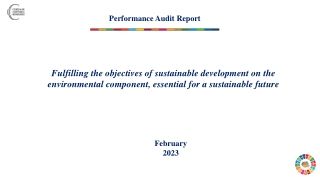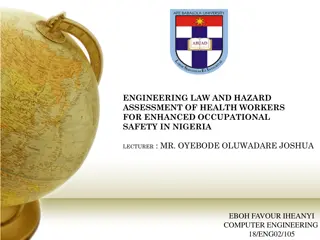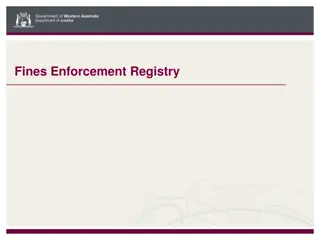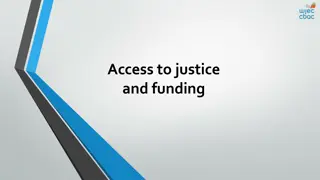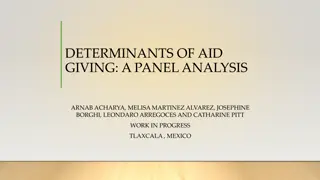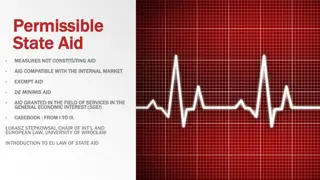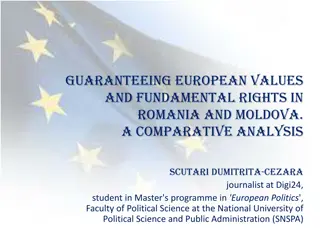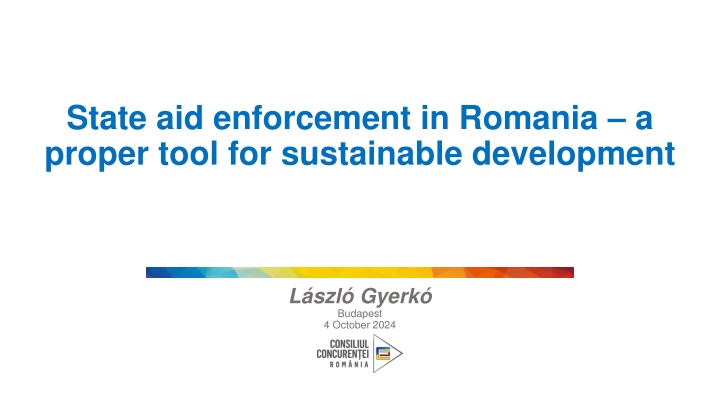
State Aid Enforcement in Romania: A Proper Tool for Sustainable Development
This presentation discusses the role of state aid enforcement in Romania as a tool for sustainable development, focusing on government instruments, industrial policy, competition policy, and support for businesses through various means like tax incentives, grants, and workforce development programs.
Download Presentation

Please find below an Image/Link to download the presentation.
The content on the website is provided AS IS for your information and personal use only. It may not be sold, licensed, or shared on other websites without obtaining consent from the author. If you encounter any issues during the download, it is possible that the publisher has removed the file from their server.
You are allowed to download the files provided on this website for personal or commercial use, subject to the condition that they are used lawfully. All files are the property of their respective owners.
The content on the website is provided AS IS for your information and personal use only. It may not be sold, licensed, or shared on other websites without obtaining consent from the author.
E N D
Presentation Transcript
State aid enforcement in Romania a proper tool for sustainable development L szl Gyerk Budapest 4 October 2024
Topics Supporting business: Government tools State aid an instrument at hand State aid in EU Romania state aid policy after accession (national and local level) Industrial policy vs. competition policy Competition Council - a dual role
Supporting business: Government tools (1) Administrative instruments: Regulatory Simplification. Educational System. Health System. Judicial System. Antitrust Agency. Infrastructure Investments. Public Procurement Programs. Access to Export Markets.
Supporting business: Government tools (2) State aid: Tax Incentives. Grants, Subsidies or Capital infusion. Loan Guarantees. Business Advisory Services. Workforce Development Programs. Research and Development and Innovation (R&D&I) Support. Small Business Assistance Programs.
State aid an instrument at hand (1) State aid - a versatile and vital tool for governments to support businesses, drive innovation, and achieve policy objectives, while the EU rules ensure that aid is used responsibly and effectively. Financial Support for Businesses. Encourages Regional Development. Promotes Innovation and Research. Supports Job Creation and Retention.
State aid an instrument at hand (2) Boosts Small and Medium-Sized Enterprises. Environmental and Sustainability Initiatives. Crisis and Recovery Tool. Facilitates Infrastructure Development. Fosters Competitiveness. Complies with EU State Aid Regulations. Public-Private Partnerships.
State aid in EU (1) Source EC Scoreboard State aid data
Romania state aid policy after accession (1) Source EC Scoreboard State aid data
Romania state aid policy after accession (2) State aid granted in Romania during 2007-2022 per objectives: Source EC Scoreboard State aid data
Romania state aid policy after accession (3) State aid granted in Romania during 2007-2022 per instruments Source EC Scoreboard State aid data
Romania state aid policy after accession (4) National level: Regional development: In the period from 2007 to 2023, the Ministry of Finance supported the business environment by running the multi- annual Program "State aid for the financing of investment projects (GBER art. 14 Regional development): - 291 investment projects were approved for financing, - which amount approx. EUR 7.43 billion, - which generates over 57,000 new jobs, - which have a direct contributions to regional development through (contributions and taxes) over 4 billion Euros, - with state aid of maximum EUR 2.37 billion.
Romania state aid policy after accession (5) National level: Regional development: MoF s "State aid for the financing of investment projects": The sectors of activity financed: automotive industry aeronautical industry food industry production of household appliances medical/wellness and pharmaceutical services production of machines and equipment hotel industry construction materials industry paper industry recovery of recyclable materials IT&C
Romania state aid policy after accession (6) National level: Regional development: MoF s "State aid for the financing of investment projects": The economic impact: The creation of new jobs directly at the level of beneficiary companies and indirectly, at the local level, at the level of suppliers / beneficiaries of goods and services; Contributions to the general consolidated budget and local budgets as a result of the investments; Multiplier effect (indirect contributions to the consolidated general budget and local budgets by involving other local companies - suppliers / beneficiaries); Contributions to Romania's import/export balance; Consolidation of some industrial branches with tradition in Romania; Industrial know-how ; Specialization and training of highly qualified personnel; Increasing the welfare of the population.
Romania state aid policy after accession (7) National level: Digital Transformation: Adapting to the digital era - a key challenge for Romanian businesses. State aid helps accelerate digitalization and technological innovation, ensuring competitiveness in international markets. Examples of state support include state aid schemes and programs like the National Recovery and Resilience Plan (PNRR), which support digital transition.
Romania state aid policy after accession (8) National level: Energy Independence and Green Transition: Energy Efficiency and Renewable Energy. Supporting Biogas, Biomass and Green Hydrogen . Energy Efficiency in Public Buildings. Promotion of electric vehicle recharging infrastructure. Specialized Training for Energy Efficiency. Supporting national and EU Programs: the Modernization Fund, Just Transition Operational Program, and National Recovery and Resilience Plan provide financial support for the modernization of energy systems, the promotion of clean energy technologies, and the decarbonization of industries. The ElectricUp program: installation of: - photovoltaic panel systems for the production of electricity (for own consumption) - storing system of the energy produced to increase the degree of self-consumption - at least one recharging station of at least 22 kW for electric and plug-in hybrid electric vehicles - alternative heating/cooling system.
Romania state aid policy after accession (9) Local level: Digital Transformation: Public measures for the local business environment for digital transition, implemented by the 8thRegional development agencies. De minimis aid scheme regarding digitization for the benefit of SMEs, non-governmental organizations. Energy Independence and Green Transition: Solutions: Investments in new capacities or in the modernization of existing capacities for the production of electricity/thermal energy from: biomass biogas geothermal water, solar energy Negative context: the high costs of implementing green technologies low access to financing low return on investment energy price fluctuations
Industrial policy vs. competition policy Geopolitical challenges, technological developments, and crises emerge Nations re-evaluate industrial policy Governments support their industries negative market distortions fostering competition Industrial policy (government interventions aimed at improving the structural performance of the domestic business sector) can both complement and conflict with competition policy.
Competition Council - a dual role Competition authorities have the crucial task of ensuring that industrial policies are designed in a way that supports and enhances market competition rather than distorting it. The balance between negative and positive effects on competition is vital for maintaining the dynamism of markets, which is essential for innovation and long-term economic growth. Competition authorities have a dual role. First, they act as advisors in the design of industrial policies, ensuring that these policies are pro- competitive. This advisory role is critical in sectors where government intervention is deemed necessary, such as in emerging technologies or in industries affected by global crises. By embedding competition principles into the design of industrial policy, authorities can help mitigate the risks of market distortion and ensure that government interventions do not stifle innovation or reduce market efficiency. Second, competition authorities are responsible for enforcing competition laws in sectors targeted by industrial policy. Effective enforcement ensures that these sectors remain competitive, even in the presence of government intervention. This enforcement role is particularly important in industries where the risk of anti-competitive behaviour is high, such as in markets with significant government subsidies or where there is a tendency toward natural monopolies.
Competition Council - a dual role The global nature of today's markets adds another layer of complexity to the relationship between industrial policy and competition policy. Actions taken by one jurisdiction can have significant implications for global competition, especially in highly interconnected industries. As such, there is a need for international coordination among competition authorities to ensure that industrial policies implemented in one country do not create unfair advantages in global markets. In conclusion, the role of competition authorities in reconciling industrial policy with competition principles is more critical than ever. As governments increasingly turn to industrial policy to address modern economic challenges, the expertise of competition authorities will be indispensable in ensuring that these policies are designed and implemented in a way that fosters, rather than hinders, competitive markets. This delicate balancing act will be key to achieving sustainable economic growth in the years to come.
Thank you for your attention! L szl GYERK Romanian Competition Council, Competition Councilor, member of the RCC Board laszlo.gyerko@consiliulconcurentei.ro

